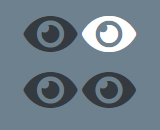Thank you for your participation!
Your Score is: / 50
Correct List of Differential Diagnoses: / 30
Correct Order of Differential Diagnoses: / 20
Our Differential:
Your Differential:
Our Diagnosis:
Primary Determinant:
Exam Results
Exam:
Ophthalmologic exam was completely normal, in terms of pupil exam, ocular motility, visual field testing and fundus appearance. Intraocular pressures were 20 mmHg OD and 21 mmHg OS.
Case Summary
This patient has a heart dysrhythmia causing transient episodes of low blood pressure. The important part of the history is that they can occur while he is sitting at rest, which points towards an intermittent heart rhythm disturbance. Other causes from overtreatment of blood pressure usually become symptomatic when changing posture which causes a sudden drop in blood pressure. In this patient example, one would refer for evaluation of a heart dysrhythmia and usually a 24-hour heart monitor would be ordered or an event heart monitor that the patient activates during an episode. If the episodes only occurred with postural changes, then the blood pressure treatment is most likely too aggressive, and the patient may need 24-hour ambulatory blood pressure monitoring to determine how much the blood pressure fluctuates and if his blood pressure medication needs adjustment.
The darkening of the peripheral vision first is a sign that there is decrease in perfusion pressure and blood flow to the central retinal artery. This is because the perfusion pressure is highest in the branches of the central retinal artery supplying the macula and lowest in the peripheral retinal branches of the central retinal artery. So, when the blood pressure drops, the peripheral retina is the first area that is affected, followed by the central retina, if the blood pressure drops low enough.
If the darkening of vision in both eyes occurs simultaneously in the center of vision and not in the periphery, then one should consider that the decrease in blood flow is affecting the occipital pole in primary visual cortex. Although the blood supply to the occipital cortex pole (topographically mapping to the central visual field) may vary, developmentally from one person to the next, most people have a dual blood supply to the occipital pole from both the distal branches of the posterior cerebral arteries and the middle cerebral arteries, forming a “watershed zone” at the occipital pole. Watershed zones of the circulation are where two blood supplies feed an area of the brain and the intersection of the two blood supplies have the lowest perfusion pressure, making it susceptible to drops in blood pressure.
Emboli are usually unilateral and not simultaneous and would not affect the peripheral retinal first, followed by the central retina. If emboli are coming from the carotid artery on one side then, the episodes usually would occur only in the eye on the ipsilateral side. If there are multiple episodes, some in the right eye and some in the left eye, then an embolic source would be looked for in the aorta or from the heart.
Preparation Planning : Case Review #31921375
Malmö, Sweden
October 2023
Assignment Instructions
Purpose
The purpose of this assignment is to work through one case at a time of a patient presenting with Transient Visual Loss. The differential diagnosis you provide will be graded and the score reported anonymously to the instructor. The goal of this exercise is to enhance classroom discussion and your answers may be presented in the class as talking points.
How to Complete the Assignment
The assignment requires you to investigate the patient history and additional patient results to determine a differential diagnosis. The elements of the history can be requested in any order you think is appropriate. You will be required to select each element of the history you think is most relevant to the patient’s chief complaint in a step-by-step manner, then you will be given the patient history for your inquiry, and then you will then reorder the Ranked Diagnosis elimating possbilities by clicking the trash can You will then repeat the process to determine other parts of the history that you think are the most relevant, until you are ready to submit your refined differential diagnosis of probable entities, ranked in order of their likelihood. You may enter your differential diagnosis at any time by clicking the "Differential Diagnosis" button. Once the diagnosis is submitted the assignment is complete and no further action is required until attending the lecture, where each case will be discussed as a group interaction.
Scoring
- The Student begins with a maximum 50 points
- 30 points are awarded for having all CORRECT Diagnoses present in your Differential
- Points will be deducted for selecting an incorrect diagnosis
- 20 points are awarded for having all Diagnoses in the CORRECT order of most to least likely
- Points are awarded for having each Diagnosis the CORRECT order
After the Lecture
You will be provided with a link to review the suggested way to work through the case along with keys points for evaluating each piece of the information from the patient history.
Case Review #31921375
Patient Presentation
Bilateral Transient Visual Loss
Click on the Cards Below to Learn More
Bilateral vs Unilateral

Bilateral vs Unilateral
Bilateral
Duration

Duration
15-20 seconds duration
Activity during the episode

Activity during the episode
Episodes occurred while sitting, and while driving, and some occur after getting out of bed in the middle of the night to use the bathroom.
Pattern of visual loss

Pattern of visual loss
He says that the peripheral vision starts to go dark first in both eyes, and then the center of his vision goes out in the right and left eye at the same time. As the episode ends, the reverse occurs; the center of vision in the right and left eye starts to come back first and then the peripheral vision of both eyes starts to come back to normal.
Other Symptoms

Other Symptoms
During the episodes he feels a little 'foggy' as if he might faint (pre-syncopal).
Current Medication

Current Medication
He is on medications for high blood pressure, including a beta-blocker two times/day, and angiotensin inhibitor, and a diuretic.
How to "Score" Point
- The Student begins with a maximum 50 points
- 30 points are awarded for having all CORRECT Diagnoses present in your Differential
- Points will be deducted for selecting an incorrect diagnosis
- 20 points are awarded for having all Diagnoses in the CORRECT order of most to least likely
- Points are awarded for having each Diagnosis the CORRECT order
Patient Presentation
Bilateral Transient Visual Loss
Click on the Cards Below to Learn More
Bilateral vs Unilateral

Bilateral vs Unilateral
Bilateral
Duration

Duration
15-20 seconds duration
Activity during the episode

Activity during the episode
Episodes occurred while sitting, and while driving, and some occur after getting out of bed in the middle of the night to use the bathroom.
Pattern of visual loss

Pattern of visual loss
He says that the peripheral vision starts to go dark first in both eyes, and then the center of his vision goes out in the right and left eye at the same time. As the episode ends, the reverse occurs; the center of vision in the right and left eye starts to come back first and then the peripheral vision of both eyes starts to come back to normal.
Other Symptoms

Other Symptoms
During the episodes he feels a little 'foggy' as if he might faint (pre-syncopal).
Current Medication

Current Medication
He is on medications for high blood pressure, including a beta-blocker two times/day, and angiotensin inhibitor, and a diuretic.
How to "Score" Point
- The Student begins with a maximum 50 points
- 30 points are awarded for having all CORRECT Diagnoses present in your Differential
- Points will be deducted for selecting an incorrect diagnosis
- 20 points are awarded for having all Diagnoses in the CORRECT order of most to least likely
- Points are awarded for having each Diagnosis the CORRECT order